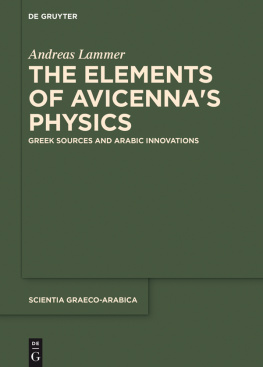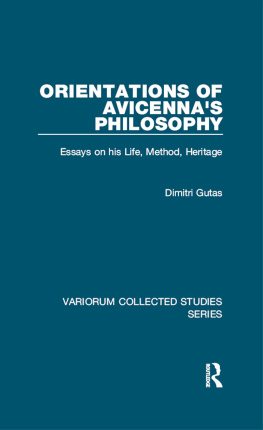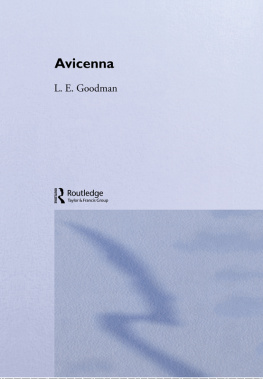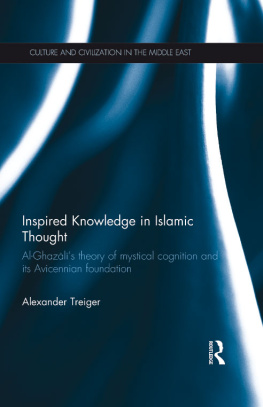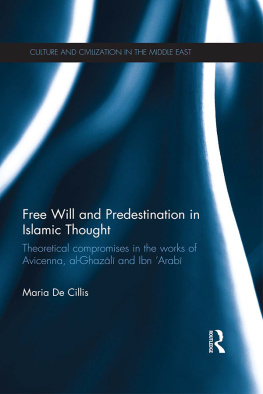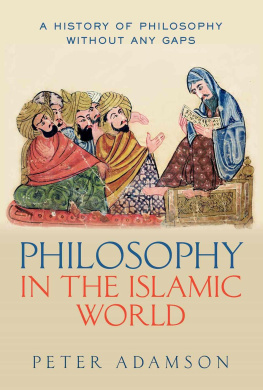Contents
Guide

Andreas Lammer
The Elements of Avicenna s Physics
Scientia Graeco-Arabica

Herausgegeben von
Marwan Rashed
Band 20

In summer 2016, this study was accepted as a doctoral dissertation at the Faculty of Philosophy, Philosophy of Science and the Study of Religion at LMU Munich.
The BRAIS-De Gruyter Prize for 2017 has been awarded to Andreas Lammer for this monograph.
ISBN 978-3-11-054358-2
e-ISBN (PDF) 978-3-11-054679-8
e-ISBN (EPUB) 978-3-11-054608-8
ISSN 1868-7172
Library of Congress Cataloging-in-Publication Data
A CIP catalog record for this book has been applied for at the Library of Congress.
Bibliographic information published by the Deutsche Nationalbibliothek
The Deutsche Nationalbibliothek lists this publication in the Deutsche Nationalbibliografie; detailed bibliographic data are available on the Internet at http://dnb.dnb.de.
2018 Walter de Gruyter GmbH, Berlin/Boston
Arabic font: Amiri, Khaled Hosny, http://www.amirifont.org/
www.degruyter.com

To my parents, Ingrid and Herbert Lammer, with gratitude.

So eine Arbeit wird eigentlich nie fertig;
man mu sie fr fertig erklren,
wenn man nach Zeit und Umstnden
das Mglichste gethan hat.
Johann Wolfgang von Goethe
in Caserta am 16. Mrz 1787
List of Abbreviations
Plato
| Alc. I | Alcibiades I |
| Leg. | Laws |
| Parm. | Parmenides |
| Phd. | Phaedo |
| Phdr. | Phaedrus |
| Plt. | Politicus |
| Rep. | Republic |
| Tim. | Timaeus |
Aristotle
| Cat. | Categories |
| De int. | De interpretatione |
| An. pr. | Prior Analytics |
| An. post. | Posterior Analytics |
| Top. | Topics |
| De soph. el. | De sophisticis elenchis |
| Rhet. | Rhetoric |
| Poet. | Poetics |
| Phys. | Physics |
| Cael. | De caelo |
| De gen. et corr. | De generatione et corruptione |
| Meteor. | Meteorologica |
| De an. | De anima |
| De mem. | De memoria et reminiscentia |
| Hist. anim. | Historia animalium |
| De part. anim. | De partibus animalium |
| De motu anim. | De motu animalium |
| De gen. anim. | De generatione animalium |
| Met. | Metaphysics |
| Eth. Nic. | Nicomachean Ethics |
| Eth. Eud. | Eudemian Ethics |
Plotinus
List of Figures and Tables
Preface
This study is an examination of texts of historic value, in particular those that were composed by the philosopher and physician Avicenna (d. 428/1037). For this reason, it relies heavily on quoting, reading, translating, and understanding passages from primary texts. The following rules have been adopted in presenting and working with these passages.
Passages in quotation are presented in their original language together with an English translation. In the case of Aristotle, texts are quoted in Greek and English together with a historical Arabic translation, if extant and available. At the same time, it should be clear that simply any Arabic translation from the second/eighth to the fourth/tenth century provides a modern interpreter with valuable information about a certain terminology and understanding that was used to render the Greek text into Arabic at around Avicennas own times.
In this regard it is to be noted, too, that the historical Arabic translations may naturally deviate from our established Greek texts in various respects. Such differences are only occasionally mentioned, as it is not the subject of this study to assess the quality and accuracy of the Arabic translations or of the Greek manuscripts and Syriac intermediaries from which they were produced. Moreover, such remarks are clearly only of limited value in a study on Avicennas philosophy as long as we continue to lack reliable information about which translations he primarily relied on in his philosophical education and formation.
All Greek texts are quoted following the available, often critical, editions listed in the bibliography. Arabic texts are quoted on the basis of the available, rarely critical, editions listed in the bibliography but have silently been adapted so as to conform to a consistent orthography and punctuation.
The transliteration of Arabic terms follows, for the most part, the rules laid down by the Deutsche Morgenlndische Gesellschaft. Exceptions include the handling of sun letters (e.g., al-aba instead of a-aba ) and of diphthongs ( aw and ay instead of au and ai ). In the transliteration of Persian terms, I decided against classicising the spelling, taking my cue from contemporary pronunciation (e.g., ketb instead of kitb ).
Furthermore, I took the liberty of adding Greek and Arabic terms in brackets at any time and to any quotation, be that from primary texts or from the secondary literature. Likewise, I have allowed myself the removal of any such earlier addition by the original editor, translator, or author from a quoted passage, if I deemed it inadequate or distracting.
It often happens that I quote from an earlier published translation and indicate that this translation has been modified. This can mean either that the text of the earlier translation has been slightly modified (such as changing the tense of a verb or replacing a noun) or that it has been heavily modified (such as changing the structure of the sentence). As it is, most quoted translations have been modified, not only in order to provide what I consider to be a better or more correct translation but also to obtain a clear and straightforward terminology throughout this study. Terms such as and mabda , for example, have been translated usually and consistently as principle, even though other translators, in various contexts, chose different expressions, such as beginning, source, and origin.
In my own translations, I often strive to follow the Arabic original closely, even in its syntax and word order. On occasion, the resulting translations may appear to be less fluent, or pleasant, in English but, so I hope, no less adequate for a thorough examination of text, thought, and terminology.
As a rule, references to primary texts always indicate the title of the work, the part, the chapter, and the subsection, if applicable, to which a certain passage refers or from which a given translation has been taken in addition to page numbers with line numbers. It is my sincere belief that modern scholarship would benefit from a strict observance of this rule.

